On a very warm Saturday morning, 14 ringers attended the ART Module 2F course at All Saints’
church, Marsworth, Bucks. The delegates were from near (Marsworth tower), slightly further afield (Bucks, Beds and Oxon) and some distance away (near Peterborough and Basingstoke).

All Saints’ Church, Marsworth (6)
Paul, our tutor himself had driven over 2 hours from Shropshire. Some of us were attending an ART teaching course for the first time, while others (myself included) had previously attended the Module 1 course.
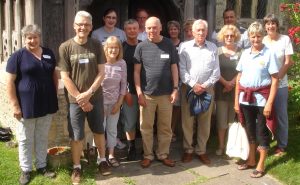
Course delegates outside the Church
We were made very welcome by Richard, Rose and Marley the Welsh Sheepdog. After introductions, Paul took us through the course agenda and Foundations skills through a short presentation.
What I liked about the course was that most of the time was spent on practical activities on the six tied bells in the tower, linked to the simulator, with enough time for everyone to have a turn at ringing. Time was also given to discussion and sharing of our experiences, which was most useful.
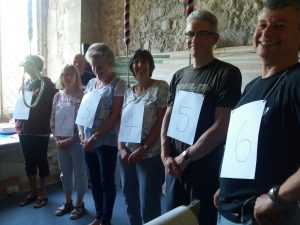
Learning to ring by ‘place’
Our first practical session focussed on handling and listening skills, essential for good bell control and accurate striking. Exercises included ringing the bells at alternate handstroke and backstroke, removing the visual cue of sally position and hand clapping exercises to introduce new ringers’ position in rounds, as well as the open handstroke lead gap. We also rang simple tunes like “Twinkle twinkle little Star” to practise timing and standing the bell at hand and back.
After a short break, we practised more listening and awareness skills, including “Lottery” (drawing cards to determine striking order) and moving from rounds to “firing” (all bells striking together) then gradually back to rounds starting with the tenor. The session concluded with call change exercises including standing in a row with numbered placards, swapping places when called and calling changes by places, preparing the learner to remember their place and count places.
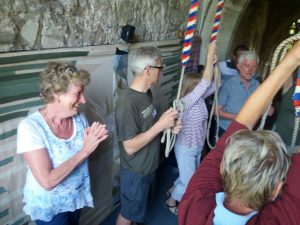
Call changes by place
After lunch we had a short presentation and discussion about running a band, coaching styles,
motivating team members and setting goals.
Our afternoon practical sessions included introducing leading and Kaleidoscope ringing. We
practised long and short places and dodging before introducing Mexican Wave, with a twist – the reverse wave! In smaller groups we selected specific scenarios from working on dodging, using Kaleidoscope ringing for service ringing to using it to introduce advanced concepts such as Treble Bob dodge and place making.
Our final practical sessions took us through exercises working towards Plain Hunt. The team worked on short methods including Bastow Little Bob Little Court Doubles and Cloister Doubles to introduce making 2nds, thirds, dodging and covering .
Finally, Paul took us through the accreditation process before we went on our separate ways.
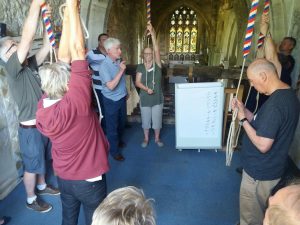
What did I get out of it?
Although I had previously already introduced a number of the Foundation exercises to my ringing practices, it was really useful to have the opportunity to work with Paul and other ringing teachers on areas that I have only briefly worked on or not used at all.
The course gave ample time to practise the teaching and execution of foundation exercises with
frequent opportunities to share ideas.
I now feel more empowered to introduce rounds and call changes to novice ringers, run handling and listening practices for all the team and develop kaleidoscope ringing to work on places, dodging and other elements of work used in methods. I intend to introduce Bastow Little Court and Cloister Doubles to further develop those skills. I will also discuss with my band what continues to motivate them and agree achievable, but challenging goals and to work on my coaching style.
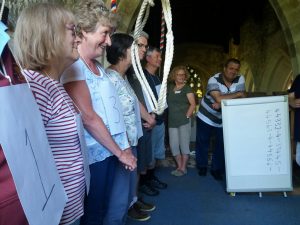
I would recommend this course to anyone already leading, or intending to lead tower practices for new or experienced ringers working towards Plain Hunt or simple methods.

